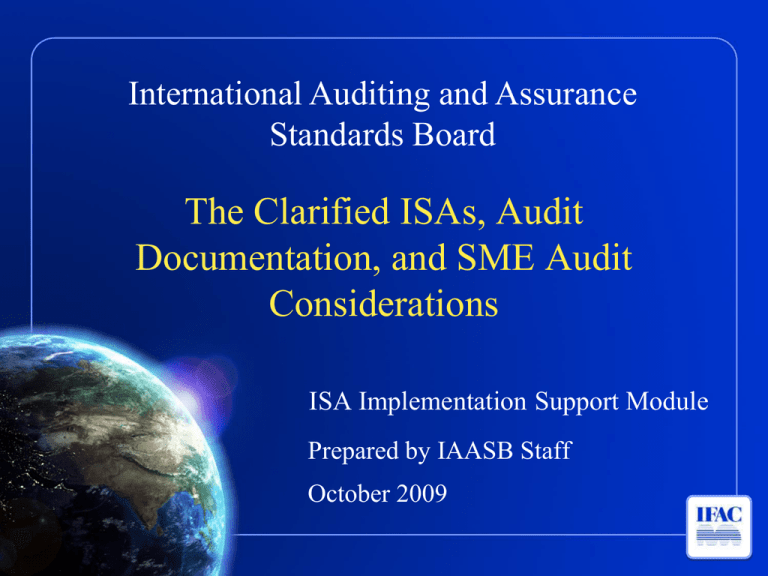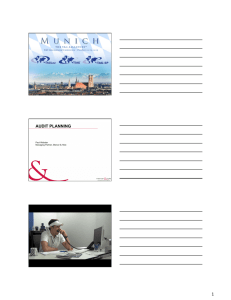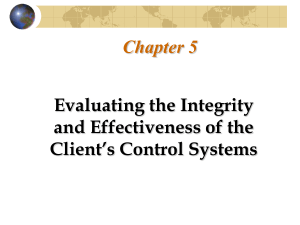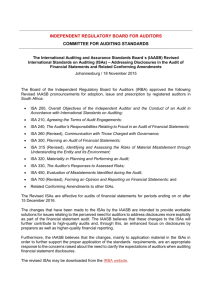
International Auditing and Assurance
Standards Board
The Clarified ISAs, Audit
Documentation, and SME Audit
Considerations
ISA Implementation Support Module
Prepared by IAASB Staff
October 2009
Overview
• Understanding an ISA Audit
• The Clarified ISAs
– Elements of the Clarified ISAs, SME audit
considerations, and additional aspects of ISA 200
• Audit documentation
– Objective, SME audit considerations, and
additional aspects of ISA 230
2
Understanding an ISA Audit
ISA 200, Overall Objectives of the Auditor,
and Conduct of an ISA Audit
• Starting point in understanding an ISA audit;
umbrella standard to all ISAs
• Purpose, nature, and scope of an ISA audit
• Overall objectives of auditor
– To obtain reasonable assurance, and
– To report in accordance with auditor findings
Failure to achieve carries reporting or withdrawal
implications
3
Understanding an ISA Audit
ISA 200, Overall Objectives of the Auditor,
and Conduct of an ISA Audit
• Requirements addressing auditor’s general
responsibilities
• Concepts relevant to an audit
• Scope, authority, and structure of ISAs
4
Clarified ISAs
Elements
• Four distinct sections
– Introduction; Objectives; Requirements; and
Application & Other Explanatory Material
– Definitions section as well, in most cases
• Together all sections comprise the Standard
• Required to have understanding of entire text
to understand objective stated in an ISA and to
apply requirements properly
5
Elements of Clarified ISAs
Introduction
• Scope of ISA
– E.g., relationship to other ISAs, any specific
limitations of the applicability of the ISA, etc.
• Essential contextual information
– E.g., context in which the ISA is set, respective
responsibilities of auditor and others, etc.
• Effective date
– Early application permitted unless otherwise stated
6
Elements of Clarified ISAs
Objectives
• Underpin ISA’s principles-based approach
• Set out aim of auditor and what needs to be
accomplished
• Provide linkage between ISA requirements and
auditor’s overall objectives
• Proper application of requirements expected to
provide a sufficient basis for achievement of
objectives; however, ISA requirements cannot
anticipate all circumstances
7
Elements of Clarified ISAs
Objectives
• To be used in planning and performing the
audit to
– Determine need for additional audit procedures
– Evaluate whether sufficient appropriate evidence
has been obtained
• To be understood in context of the overall
objectives of the auditor and having regard to
interrelationships amongst ISAs
8
Elements of Clarified ISAs
Objectives
• If an objective in a relevant ISA cannot be
achieved, evaluate whether this prevents
achievement of auditor’s overall objectives
– Represents a significant matter requiring
documentation
• Circumstances that may give rise to failure, e.g.,
– Unable to comply with a requirement(s)
– Not practicable or possible to carry out additional
procedures auditor judges necessary
9
Elements of Clarified ISAs
Requirements
• Designed to enable achievement of objectives
• Compliance with ISAs claimed only when auditor
has complied with all relevant ISAs
• In exceptional circumstance, departure from a
relevant requirement permitted
– Where the requirement is for specific procedure and
that procedure would be ineffective
– Perform alternative audit procedures to achieve aim of
the requirement
10
Elements of Clarified ISAs
Application & Other Explanatory Material
• Integral part of the standard providing
– Background information on matters addressed
– Further explanation of a requirement, e.g., what it
means or is intended to cover
– Guidance for carrying out requirements, e.g.,
examples of procedures
• Does not impose a requirement, but is relevant
to proper application of the requirements
11
Clarified ISAs
Considerations Specific to SME Audits
• Structure of Clarified ISAs heavily influenced by
need to ensure applicability of ISAs to audits of
entities of all sizes, in particular SMEs
– Separate section for requirements to help readability
and clarification of conditional requirements
– Requirements capable of being applied
proportionately
– Additional guidance specific to SME audits
12
SME Audit Considerations
Considerations Specific to SME Audits
• New guidance in application material of the
ISAs providing considerations specific to audits
of smaller entities
– Typical qualitative characteristics of SMEs described
in ISA 200
– Guidance developed primarily with unlisted entities in
mind; some considerations, however, may be helpful
in audits of smaller listed entities
– Considerations do not limit responsibility to comply
with ISA requirements
13
SME Audit Considerations
Proportionality of Application of ISAs
• ISAs designed to be able to be applied
proportionately with size/complexity of an entity
– Proportionality ≠ modification of requirements
• Not every audit to be performed the same way
– Audit approaches may vary with circumstances
(simpler/more complex)
• Professional judgment needed regarding audit
procedures to meet the ISA requirements and
gather audit evidence
14
SME Audit Considerations
Proportionality of Application of ISAs
• Demonstrated in requirements, e.g.,
– ISA 260.13, where management = those charged with
governance
– ISA 315.17, absence of formal risk assessment
process
– ISA 540.13, choice of responses to assessed risks
• Demonstrated in application material, e.g.,
guidance on aspects of the audit which vary with
size, complexity, and nature of an entity
15
SME Audit Considerations
Application in an SME Context
• Basic obligation in the ISAs is to comply with all
ISAs relevant to the audit
• However, not all ISAs may be relevant in an SME
audit, e.g.,
– ISA 402, if SME does not use a service organization
– ISA 600, if SME audit is not a group audit
– ISA 610, if SME has no internal audit function
16
SME Audit Considerations
Application in an SME Context
• Even if an ISA is relevant, not all its
requirements may be relevant
– Conditional requirements need not be applied if
conditions do not exist
• Examples
– Engagement team discussion (ISA 315.10)
– Determining whether material uncertainty exists in
context of going concern (ISA 570.16)
17
Clarified ISAs
Additional Features of ISA 200
• Concepts relevant to an ISA audit
– Amplification of existing guidance, e.g., on
sufficiency and appropriateness of audit
evidence, inherent limitations of an audit, etc.
– No change to definition of reasonable assurance
and underlying audit risk model
• Professional judgment
• Professional skepticism
18
Additional Features of ISA 200
Professional Judgment
• Essential to proper conduct of an audit
• New definition and requirement
– Better articulates IAASB’s expectations
regarding exercise of professional judgment in an
audit
– Helps stress auditor’s professional responsibility
for the exercise of judgment in a sound,
consistent, and justifiable manner
19
Additional Features of ISA 200
Professional Judgment
• New guidance
– Addresses how judgment may be evaluated
– Reminds auditor of need to consult on difficult or
contentious matters and for significant judgments
to be evidenced
– Makes clear that judgment is not to be used as the
justification for decisions that are not supported
by the facts and circumstances or sufficient
appropriate audit evidence
20
Audit Documentation
ISA 230, Audit Documentation
• Objective
– Sufficient appropriate record of the basis for
auditor’s report
– Evidence that audit planned and performed in
accordance with ISAs
• Benefits, e.g.,
– Facilitates supervision and review, evaluation of
evidence obtained and conclusions reached,
internal and external inspections, etc.
21
Audit Documentation
Benchmark
• Sufficient to enable an experienced auditor,
having no previous connection with the audit, to
understand
– Nature, timing, and extent of the audit procedures
– Results of audit procedures , and the audit evidence
obtained
– Significant matters arising during the audit, the
conclusions reached thereon, and significant
professional judgments made in reaching those
conclusions
22
SME Audit Considerations
Proportionate Documentation in an SME
Context
• Appropriate documentation need not be
burdensome
• Application designed to be proportionate,
efficient, and effective
– For SMEs, likely simple in form and relatively brief
– ISAs explicitly encourage exercise of professional
judgment in determining form and extent of
documentation that make most sense
23
SME Audit Considerations
• Focus is on meaningful documentation
– “… it is neither necessary nor practicable for the
auditor to document every matter considered, or
professional judgment made, in an audit. …”
– “it is unnecessary for the auditor to document
separately … compliance with matters for which
compliance is demonstrated by documents
included within the audit file….” (ISA 230.A7)
• Many illustrations of how documentation can be
done in efficient and effective manner (see ISAs
24
230, 300, 315, etc.)
Audit Documentation
Additional features of ISA 230
• Documentation of items/matters tested, who
performed the audit work, reviewer, and dates
• Documentation of discussions of significant
matters with management, those charged with
governance, and others
• Documentation of departure from a relevant
requirement
– How alternative procedures achieve aim of the
requirement and reasons for departure
25
Audit Documentation
Additional features of ISA 230
• Requirements addressing matters arising after
date of auditor’s report and assembly of final
audit file
– Assembly of final audit file expected <= 60 days
of audit report date
• Clarifies relationship between ISA 230 and
documentation requirements in other ISAs
26
Note
This set of support slides does not amend or override
the ISAs, the texts of which alone are authoritative.
Reading the slides is not a substitute for reading the
ISAs. The slides are not meant to be exhaustive and
reference to the ISAs themselves should always be
made. In conducting an audit in accordance with
ISAs, the auditor is required to comply with all the
ISAs that are relevant to the engagement.
27
International Federation
of Accountants
Copyright © October 2009 by the International Federation of Accountants
(IFAC). All rights reserved. Permission is granted to make copies of this work
provided that such copies are for use in academic classrooms or for personal use
and are not sold or disseminated and provided that each copy bears the
following credit line: “Copyright © October 2009 by the International
Federation of Accountants (IFAC). All rights reserved. Used with permission of
IFAC. Contact permissions@ifac.org for permission to reproduce, store, or
transmit this work.” Otherwise, written permission from IFAC is required to
reproduce, store, or transmit, or to make other similar uses of, this work, except
as permitted by law. Contact permissions@ifac.org.
ISBN: 978-1-60815-042-7
www.ifac.org








